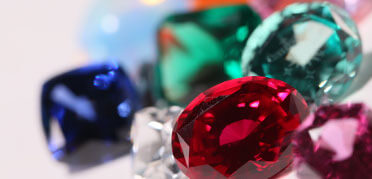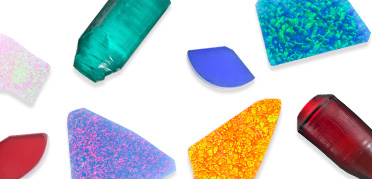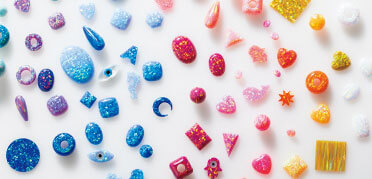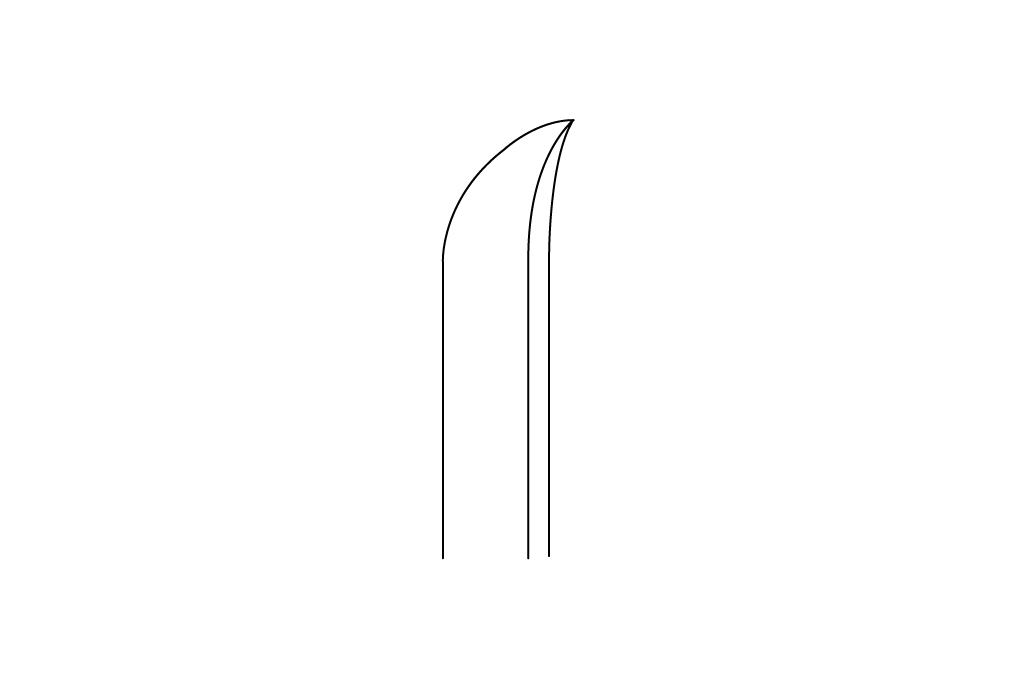Jewelry Glossary
-
T
-
Talc
Talc is the softest mineral, and it is the standard gemstone of moh's hardness 1. It's a kind of clay mineral and has gloss like candle wax. They are often confused with serpentines and calcite because of their white, green or brown color. High density and high-quality talc are called "steatite" and are used as materials for engraving.
In addition, by making talc into powder, it is used for baby powder, cosmetics, medicines and paper quality improvers. -
Tanzanite
Blue zoisite was discovered in Tanzania during the 1960s and named it "tanzanite" in 1967 by a famous brand. The production of tanzanite has increased since 1989 and it is especially popular in the United States because of its beauty and affordability. Tanzanite has strong pleochroism and features three different colors such as blue, indigo blue and reddish brown. It's easy to chip because of the low hardness, so it’s best to cut into cabochon and not us it for rings.
[Moh's hardness: 6] [Mineral type: Zoisite] -
Tennis Bracelet
The tennis bracelet is mainly composed of diamonds. This design of bracelet was popularized by a tennis player which is where the name comes from.
-
Thermal Conduction (Heat Conduction)
Transfer of heat. If heating a part of the material, heat will transfer to cooler areas, and the overall temperature will be all uniform at the end.
Platinum has the lowest thermal conduction, gold (K18) has the middle, and silver has the highest. -
Three Loop Ring
A three-loop ring is made by intertwining three domed bands. The popular Cartier three-loop "trinity ring" is sometimes referred as the "cartier ring."
-
Thumb Ring
A thumb ring is a ring to wear on a thumb. It is believed from the Ancient Roman Era that "If you wear a ring on the thumb, any dream will come true". It also has a role to protect the thumb when pulling a bow in the battle and was worn with the wish to win the battle. It is a ring that associates the strengths of perseverance after overcoming difficulties.
-
Tiara
Tiaras are a piece of jewelry worn on one's head. Usually, the design of a tiara is higher in the frontal central part and narrower towards the sides.
Some parts are removable so you can use them as a pendant, brooch, ring etc. -
Tie Bar
Tie bar is hairpin-shaped, it has enough elasticity to fasten a tie.
-
Tie Chain
A tie chain is also known as "balancing toy" (Yajirobee) in Japan, due to its precarious appearance. It secures your neckwear to your shirt with a loose chain.
-
Tie Tack
The tie tack is a short pin which is secured onto a tie with a fastener. The back has a chain and a button ring that is attached to a shirt button. Some people called it a "tie pin," but pins are typically longer, calling it tie tack is more accurate.
-
TIG Brazing (Welding)
Method of brazing without using a brazing rod. Material pieces combine together by melting a side of a base material, and TIG brazing is used when joining the platinum ring's arm.
Also, when metal gets cracked, TIG brazing may be used for repairing.
As platinum has low thermal conduction, it is easy to conduct a TIG brazing. But silver has high thermal conduction, and it needs to be given careful attention not to melt other parts of silver. -
Tiger's Eye
The striped pattern of tiger's eye is made when the iron contained in the blue asbestos is oxidized and further replaced with silica.
Its main production region is South Africa. Exporting cut stones is allowed, although exportation of rough stones is prohibited.
[Moh's hardness: 7] [Mineral species: Quartz] -
Toe Ring
A toe ring is a ring to be worn on a toe. The origin of the toe ring is "bichiya," which was a traditional decoration worn by ancient Indian women. Its demand has increased because more people enjoy fashion on feet, such as a pedicure. However, it is generally avoided wearing on index finger of foot because of meaning.
-
Topaz
Topaz can produce most color such as colorless, red, orange, yellow, and blue. Pink topaz is especially rare and valuable. It features the appearance of vertical striations on the pillar surface and a well-developed self-crystal of topaz has rhombic cross-section. Topaz is produced in hydrothermal veins by liquid containing a large amount of fluorine.
-
Tortoise Shell
A shell of hawksbill, a sea turtle, is called a tortoiseshell. It was rare from ancient times in all countries and was used for hairclips and eyeglass frames. However, imports were banned entirely in 1993. It is now substituted by plastic.
[Moh's hardness: 2.5-3] [Organic matter: Tortoise shell] -
Toughness
Toughness is the adhesive strength of a material, which means it is difficult to break. Toughness is presented only for representative gems, and the carbonado has the strongest viscosity with a toughness level of 10.
-
Tourmaline
Tourmaline is a group of more than 10 minerals with complex and wide-ranging chemical compositions and crystal structures. It comes from "turmali" which means "gravel of the jewelry" in Sinhala's language. It is also called electric stone because it generates static electricity and attracts dust. Most tourmalines that are gems are eelbaite. Tourmaline crystals have many pillars, a variety of colors are produced due to subtle differences of elements contained. There is also bi-colored watermelon tourmaline featuring two colors or 3 colors.
-
Trapiche Emerald
Trapiche, in Spanish, is the name of gears used in agricultural equipment designed to squeeze sugar cane. This emerald was given this name due to its shape resembling that of a gear. The six black partitions seen in the cabochon cut is charcoal that was trapped during the growth process of emerald.
-
Treatment
A "treatment" is a method of altering a gemstone's natural properties. As this is a form of stone processing, the value of the gemstone will decrease. Common treatments include heating, impregnation, dyeing, coating, radiation, and surface diffusion.
-
Trilliant Cut
There are two types of triangular diamond cuts.
There's the "trilliant" of the brilliant cut family and the “triangle" belonging to the step cut family.
The "trilliant" is a rounded mountain ridge while the "triangle" is a straight mountain ridge. -
Triplet Opal
High-quality opal with the play of color is very rare and valuable. Therefore, an assemblage like doublet and triplet has been made. A collection of thin white opal and milky white glass, and black glass or agate is one of the examples of triplet opal.
-
Tsavorite
The refractive index is close to sapphire (1.74), and it is excellent in qualification as a gem because the level of hardness is high. Tsavorite with medium lightness, high transparency, and mosaic pattern in beautiful green shades is considered as high quality.
[Moh's hardness: 7] [Mineral species: Grossularite garnet] -
Tumbling
Tumbling is a polishing style similar to a situation where the appearance of jewels has been washed by rivers and polished by nature. Usually, a gem is placed into a pot for tumbling polish.
-
Turquoise
Turquoise is one of the oldest mined gemstones, the most beautiful being "turquoise blue." Due to poor chemical resistance, many turquoise stones are treated with resin/oil impregnation.
[Moh's hardness: 5] [Mineral species: Turquoise] -
Twinkle Cut Chain
A twinkle cut chain is a designed cut of the cable chain. The cut metal reflects light and sparkles.
-






